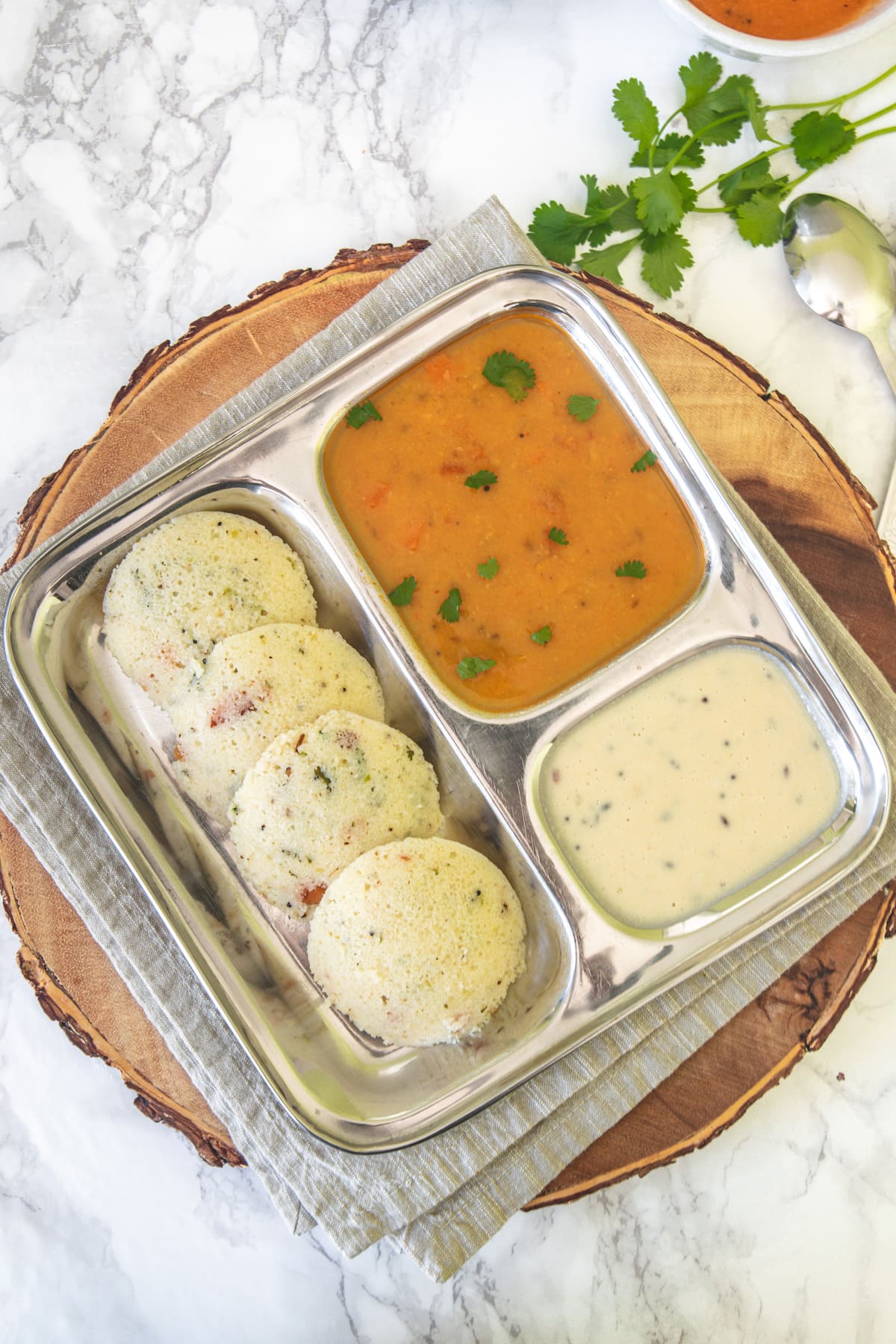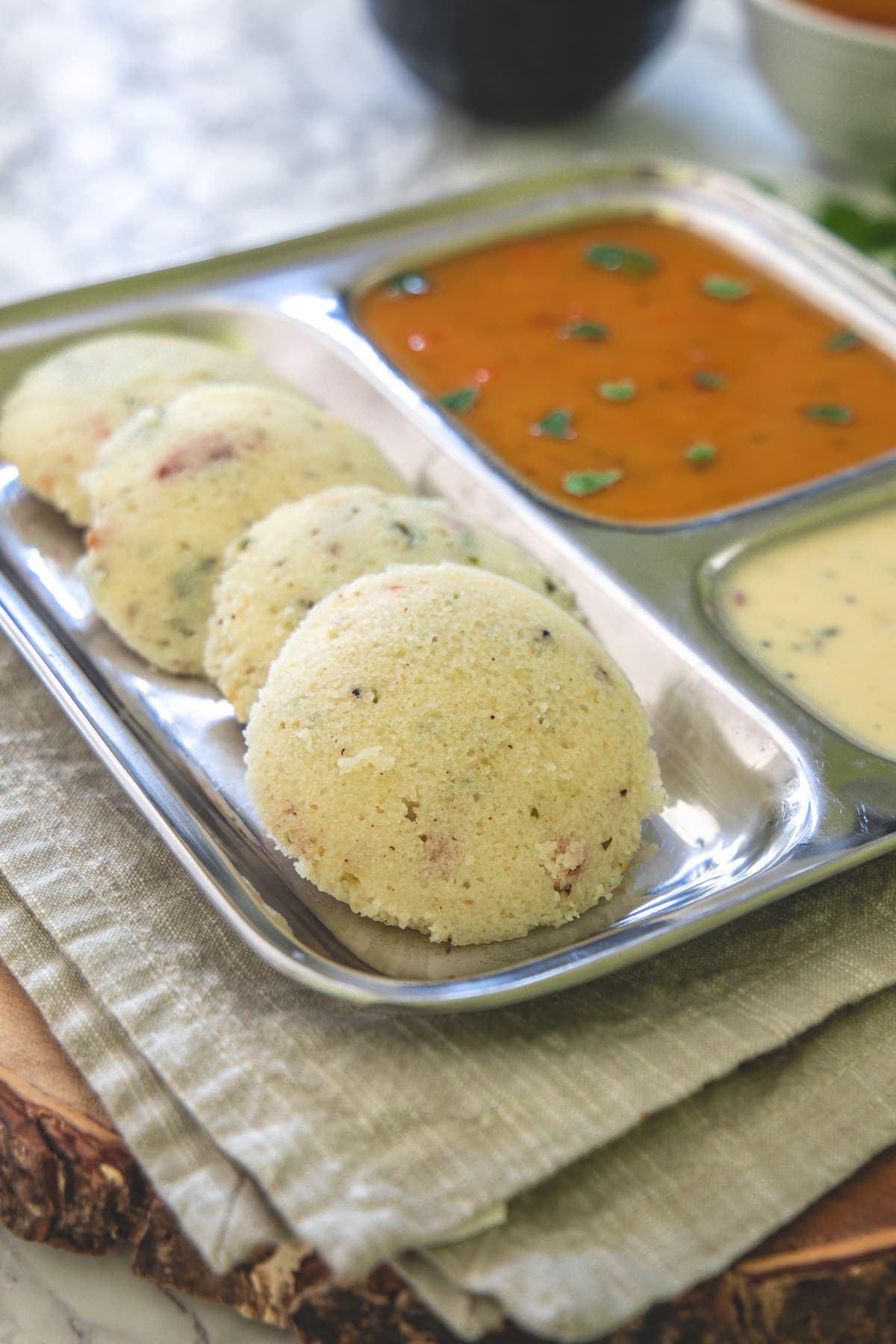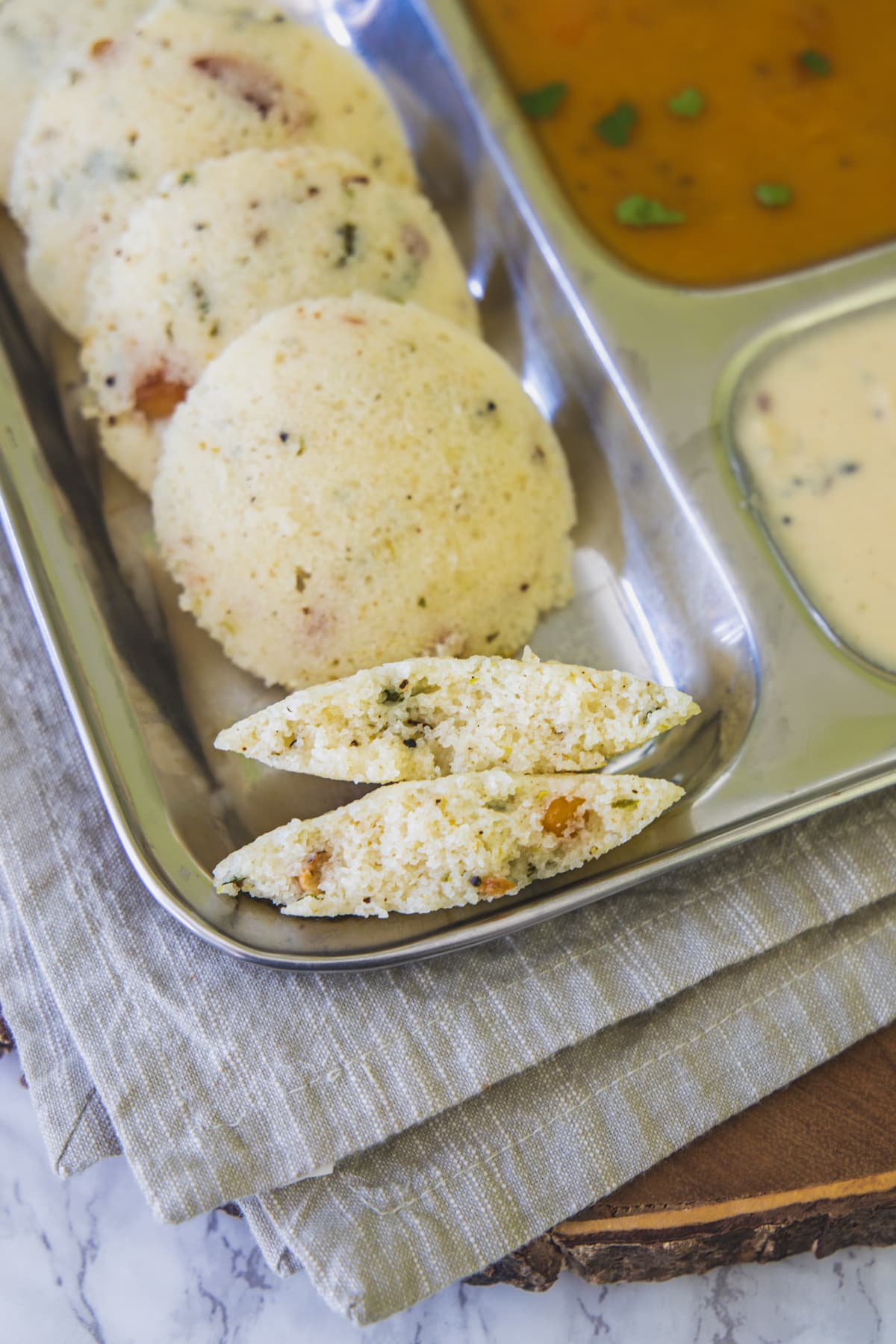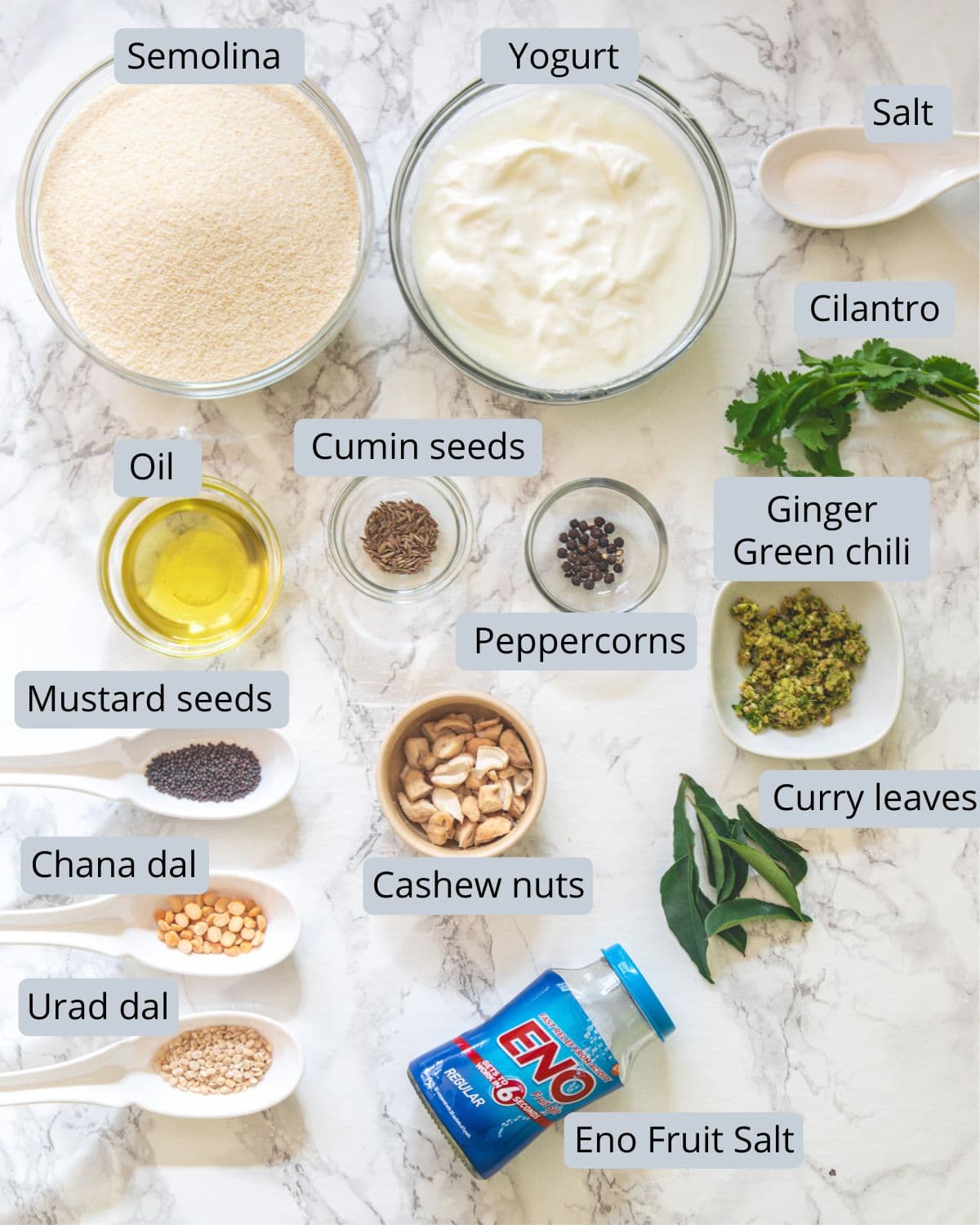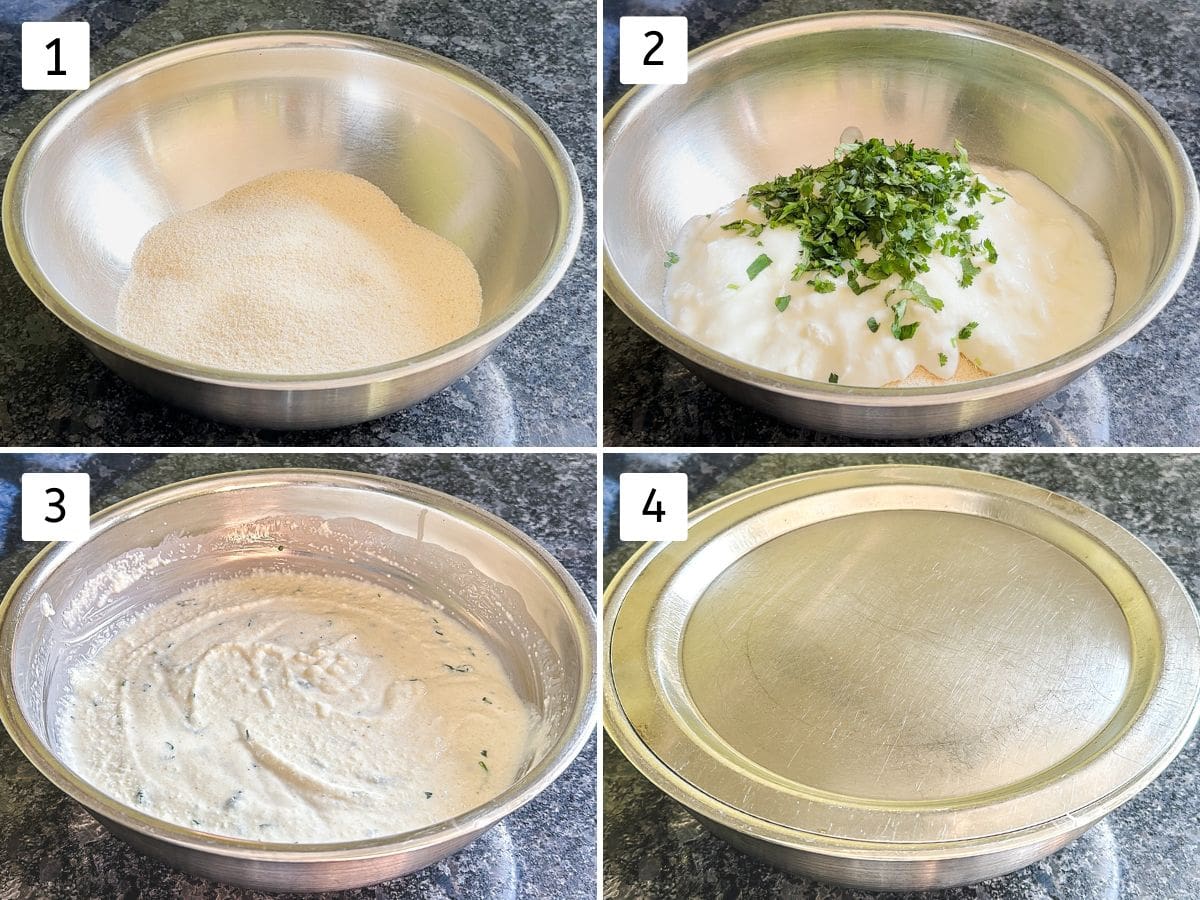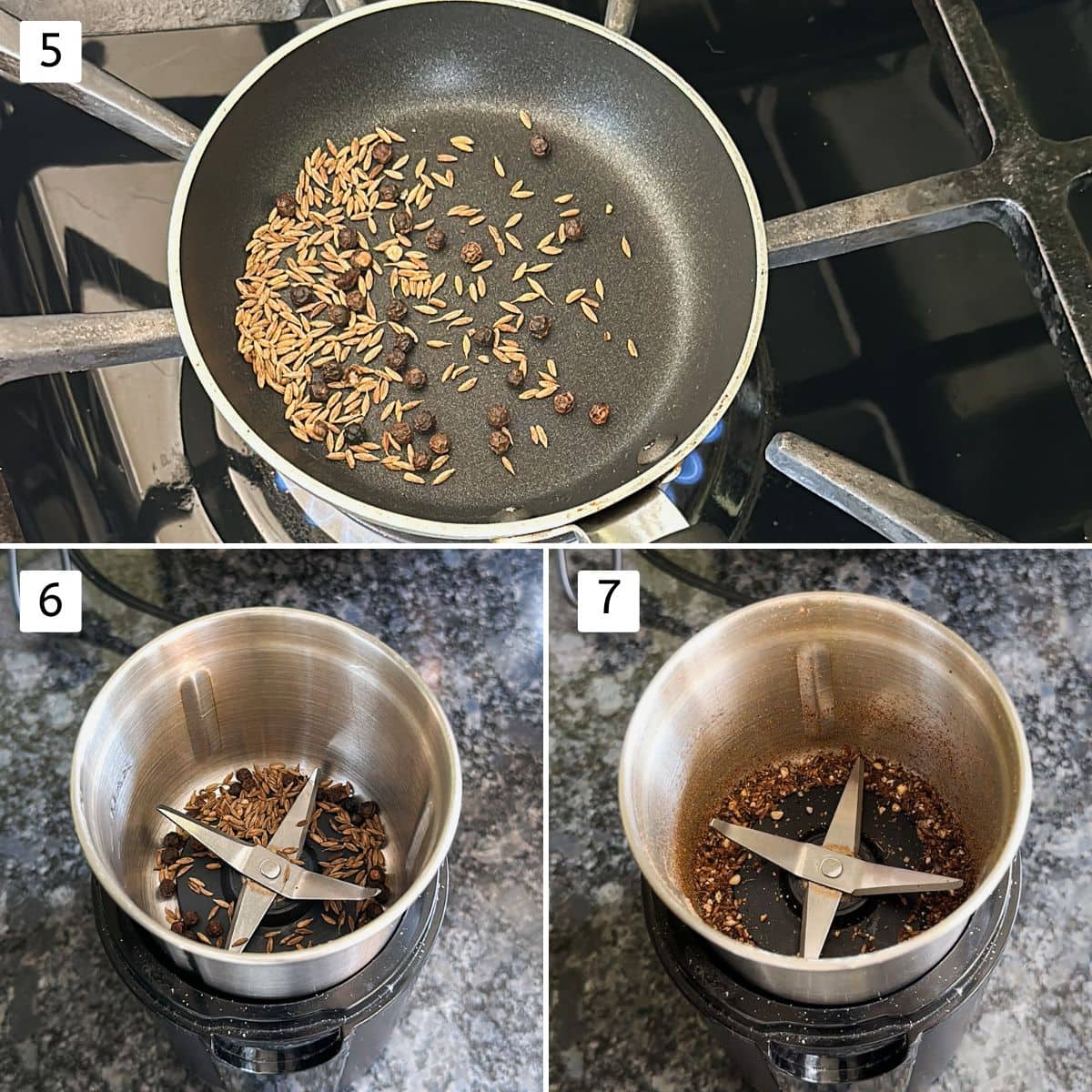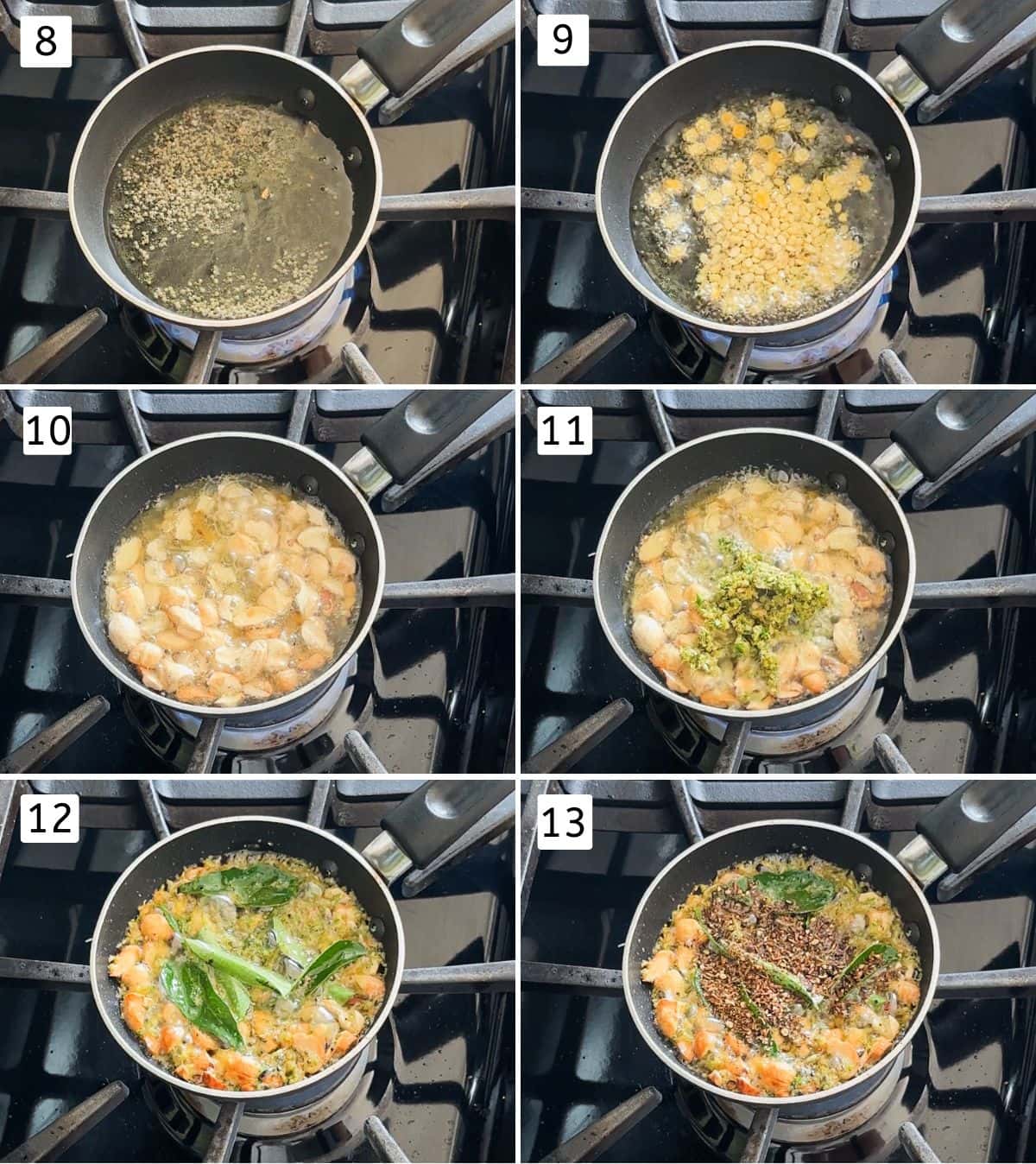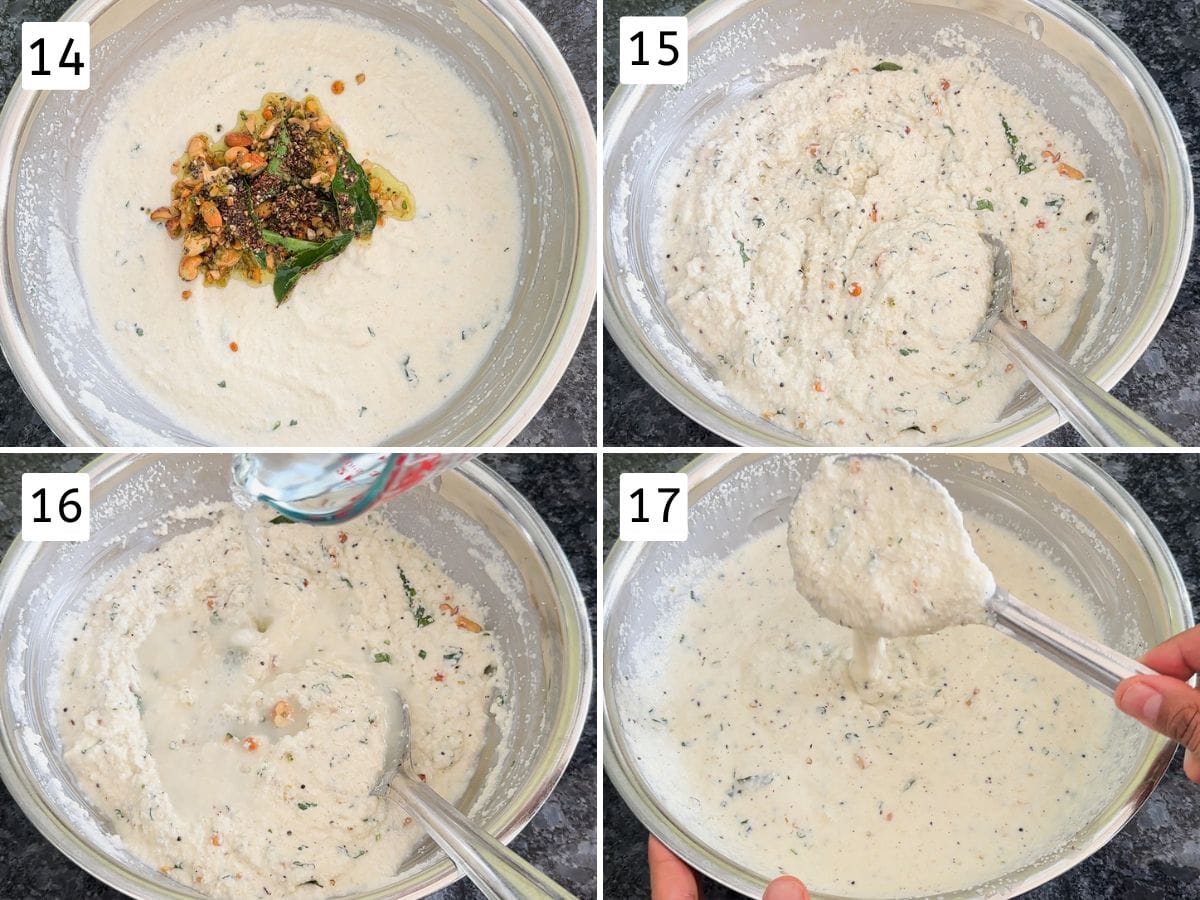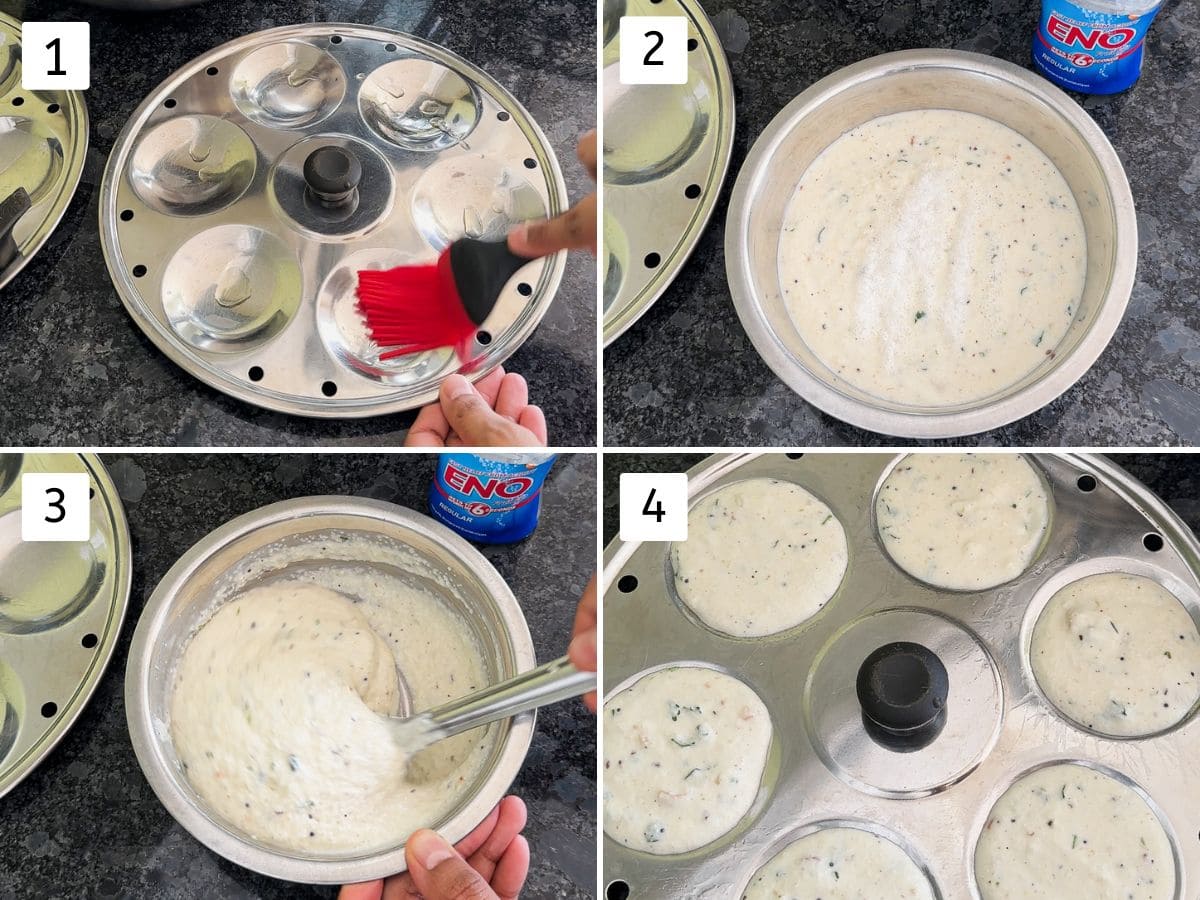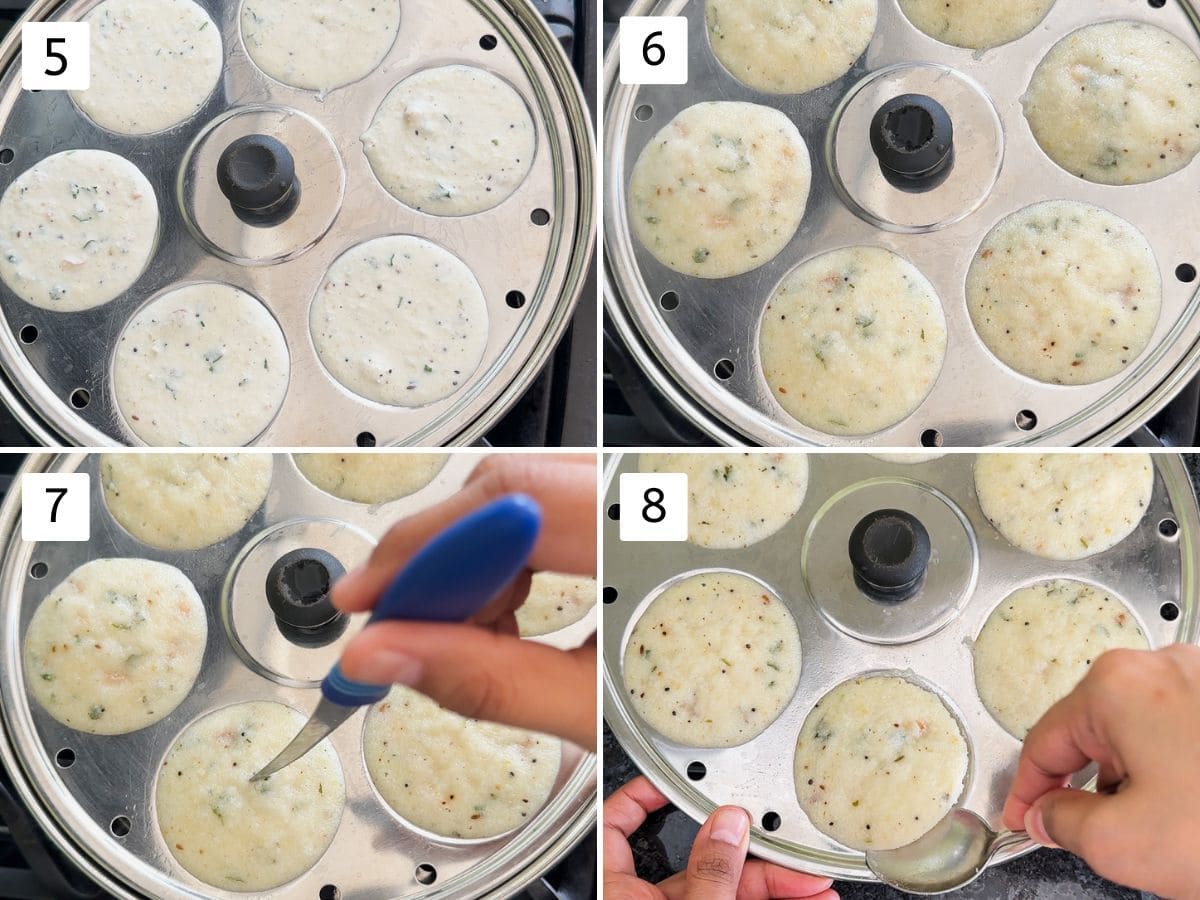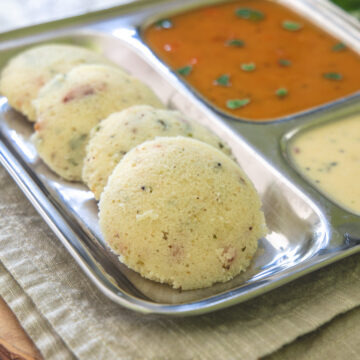Rava is also known as suji hence the name ‘suji idli’.
❤️ About This Recipe
A Little History About Rava Idli
The invention of rava idli is attributed to MTR Foods, a well-known Indian food company based in Bangalore, Karnataka. Legend has it that rava idli was created by the founder of MTR Foods, Parameshwara Maiya, in the 1940s. It is said that he came up with the idea of using semolina instead of rice and lentils to make idlis when there was a shortage of rice during World War II.
Rava idli has a mild, slightly tangy flavor with a hint of sweetness from the semolina and yogurt. The addition of coarsely ground cumin and peppercorns enhances the overall taste. The tempering adds a burst of savory and nutty flavors.
Texture:
Soft, fluffy, and moist. Light and airy, yet firm enough to hold their shape A slightly grainy texture due to the semolina, unlike traditional idli which are typically smooth. Cashews and lentils add a crunchy texture and provide a contrast to the softness of rava idli.
Rava idli gained popularity quickly due to its simplicity, convenience, and delicious taste. It has since become a staple breakfast and snack item in South Indian cuisine, enjoyed by people of all ages across India and beyond.
You’ll Love This Rava Idli Recipe
Quick: The batter comes together in under 30 minutes and one batch of steaming requires 10 minutes. No fermentation required: Just rest the batter for 20-25 minutes and it’s done vs fermenting overnight. Customizable: You can add your choice of veggies like grated carrots, beetroots, chopped peppers, peas, etc to make it nutritious.
🧾 Ingredient Notes
Semolina (Coarse Rava or Suji): I highly recommend using coarse semolina to achieve a soft, fluffy texture. Using fine semolina may result in chewy idlis. Plain Yogurt (Dahi or Curd): Always use fresh yogurt (not sour). Greek yogurt can also be used, but you may need to adjust the consistency of the batter accordingly by adding water. Water: Use water to adjust the consistency of the batter. The amount may vary depending on the thickness of the yogurt and how much water your semolina has absorbed. Eno Fruit Salt: This ingredient helps to leaven the batter, resulting in soft and fluffy idlis. Ensure the Eno fruit salt is fresh for best results. I recommend using regular (unflavored) Eno fruit salt. Cashew Nuts: I add cashews on special occasions only. Otherwise, I add peanuts. Green Chilies & Ginger: I personally prefer crushing both together in the wet jar of my spice grinder. Alternatively, you can crush them using a mortar and pestle. Another option is to use ginger paste and chopped green chilies instead. Adjust the number of green chilies according to your spice tolerance. You can de-seed them for a milder flavor.
👩🍳 How To Make Rava Idli Recipe? (Pics)
Make Rava Idli Batter 1, 2) In a bowl, combine sooji, salt, yogurt, and chopped coriander leaves. 3, 4) Add around ½ cup of water, and mix well until everything is incorporated. Set aside for 20-25 minutes to rest. 5) While the batter rests, dry roast the cumin seeds and peppercorns on medium-low heat. 6, 7) Grind into a coarse powder using a spice grinder or a mortar and pestle. 8) In a small pan, heat oil over medium heat for tempering. Once hot, add mustard seeds and let them splutter. 9, 10) Add urad dal, chana dal, and cashew nuts. Saute for a minute or until the dals and cashews turn light brown. 11, 12) Add crushed ginger-green chili and curry leaves to the tempering. Cook for 30 seconds. 13) Then turn off the heat and add the prepared cumin-pepper powder. Stir quickly. 14, 15) Immediately add this tempering to the prepared batter. Mix well to combine. 16, 17) After resting, the semolina will have absorbed most of the water, resulting in a thick batter. Add water gradually to achieve the desired batter consistency, about ½ cup. Stir well to combine. Steam Rava Idli:
- Prepare the steamer by adding water to it and bringing it to a simmer. Prepare the idli stand by greasing them well with oil. Set aside. 2, 3) Take out a portion of the batter (enough for 1 batch of rava idli) into a separate bowl. Right before steaming, add eno fruit salt to this portion of the batter. Mix it until the batter starts to bubble and becomes light and airy.
- Pour the batter into the greased idli molds. 5, 6, 7) Place the idli stand into the steamer. Steam for 10-12 minutes on medium heat or until a toothpick/knife inserted into the center of the idlis comes out clean.
- Remove the idli stand from the steamer and let it stand for 1-2 minutes. Then, using a knife or spoon, remove the idlis from the molds. Follow the same steps of adding eno fruit salt and steaming the idlis for the remaining batter.
💭 Expert Tips
Consistency of Batter: Ensure that the batter has a thick yet pourable consistency. If the batter is too thick, the idlis may turn out dense and heavy. Adjust the amount of water or yogurt as needed to achieve the right consistency. Resting Time: Allow the batter to rest for at least 15-20 minutes before steaming. This helps the semolina absorb the moisture and yields softer idlis. If possible, let the batter rest for longer for even better results. Eno Fruit Salt: Add eno fruit salt just before steaming the idlis. If added too early then Eno loses its effect and idli won’t turn soft and fluffy. Avoid overmixing after adding eno, as this can deflate the batter and result in dense idlis.
🥣 Storage Instructions
Leftover rava idli can be stored in an airtight container in the refrigerator for up to 2-3 days. Freezing: Rava idlis can also be frozen for longer storage. Once cooled, arrange the idlis in a single layer on a baking sheet and place them in the freezer until they are firm. Then, transfer the frozen idlis to a freezer-safe bag or container, making sure to remove any excess air before sealing. Label the container with the date and store it in the freezer for up to 2 months. Reheating:
To reheat refrigerated or frozen rava idlis, steam them again using a steamer or microwave. If frozen, allow the idlis to thaw in the refrigerator or countertop before reheating. Reheat the idlis for a few minutes until they are heated through and soft. Avoid overcooking, as this can make the idlis dry and chewy.
Did you try this rava idli recipe? I’d love to hear about it! Leave a review in the comment section below.
Oats Idli Rava uttapam Rava dosa Upma
